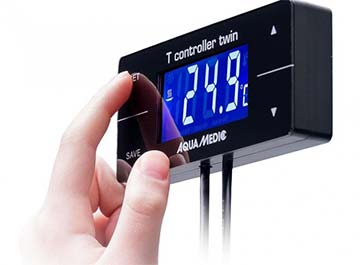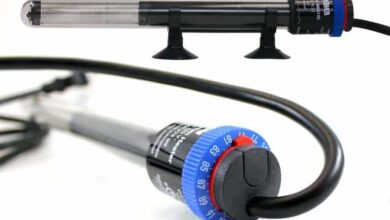Thermostats for fish tank and aquarium

Imagine waking up one morning to find that all your fish are floating upside down in your aquarium. You touch the water and discover that it is boiling. Your fish have been cooked!
This scenario, unfortunately, is more common than you think. All it takes is for your heater to stay on longer than it should, and you risk boiling your fish.
That’s where an aquarium thermostat comes in.

This important device can save the life of your fish. And today, I’m going to teach you all about it.
️ What is a fish tank thermostat?
As its name suggests, an aquarium thermostat allows you to precisely regulate the temperature of your aquarium, much more precisely than if you only used an aquarium heater.

Think of a thermostat as an external temperature controller specific to your aquarium.
There are two types of aquarium temperature controllers:
- Thermostat – Comes as a complete unit. Simply plug in the heater and you’re good to go. No more effort is required.
- DIY Theromstat – As its name suggests DIY (Do It Yourself), you buy the parts separately and create your own thermostat. Knowledge of electricity is recommended if trying to create your own.
Although the exact style of an aquarium thermostat will vary by brand, it will typically consist of three distinct parts:
▪️ Controller
The controller consists of a digital LCD display and buttons that you can use to set the desired temperature.
This is the brain of the team. The controller monitors the water in your aquarium to make sure it is always at the correct temperature.
▪️ Plug
The aquarium thermostat has a double plug to connect the heater.
It is self explanatory. This is where the plug for your aquarium heater goes.
Some fish tank thermostats come with two separate outlets, one for the heater and one for the cooler.
These are called dual thermostats and they allow the controller to heat the water when it is too cold and cool it when it is too hot.
▪️ Temperature sensor probe
The waterproof probe is located inside the aquarium and measures the temperature of the water.
Keep in mind that if you have a saltwater tank, you will need to purchase a probe that is resistant to corrosion.
️ How does the aquarium thermostat work?
Without getting bored with the complicated technical details, the operation of a temperature controller is actually very simple.
Set your tank temperature
Using the controller, the desired temperature is set. In this example, we are going to set it to 26 degrees Celsius, because that is what our friend the angelfish prefers.
The controller reads the temperature
By placing the probe that has the sensor inside the fish tank, the device will read the temperature and compare it to the temperature that has been set.
The thermostat does its job
If the temperature is colder than what you have set, the thermostat sends power to the plug which turns on the heater.
Once the temperature is reached, turn off the heater until the temperature drops again.
️ Why do you need a thermostat for your fish tank?
Chances are good that the aquarium heater you use already has a thermostat inside it. And when it reaches a certain temperature, it turns itself off. So why do you need an external thermostat for your aquarium?
Well, it turns out there are two good reasons:
▪️ Heater malfunction
The reality is that heaters fail. Your heater could fail due to a manufacturing fault, improper installation, user error, electrical failure, or any other reason.
Yes, the chances of your aquarium heater failing are low… But if it fails, your tank will overheat and you can say goodbye to your fish, plants and other inhabitants.
In fact, if you frequent any aquarium forum, you’ll find countless stories of how hobbyists have come home to chowder.
This costly accident can be prevented with a fish tank thermostat. Once the water reaches the temperature you set, the thermostat will cut power to your heater, turning it off.
If your aquarium heater also has a thermostat, then the temperature controller is an extra layer of security.
▪️ Thermostat and sensor are of better quality
I have to admit that modern aquarium heaters manage to take advantage of this device, a temperature sensor and a heating element in a small product that hardly takes up space in your tank.
But the downside is that these components are not as precise. If you need a narrow temperature range for breeding or have very sensitive fish, then you need a more accurate way of determining water temperature.
That’s where a fish tank thermostat comes in that offers accurate measurement of water temperature.

️ How to choose the right thermostat for your aquarium?
To determine the ideal thermostat for your aquarium, you must answer the following questions:
▪️ Which heater do you need to control?
As you probably know, the power of your aquarium heater is measured in watts (W). You can find the wattage of your heater printed on the box or in the manual for your aquarium heater.
The wattage needs to be in line with what the aquarium thermostat is producing, otherwise the controller may fail.
Let’s say the aquarium thermostat has an output of 500W. This means it can control one 500W heater, two 250W heaters, or any combination of heaters that add up to 500W.
But if you need the thermostat to run a 600W heater, you risk the temperature controller failing.
Therefore, you must ensure that the wattage of your heater is equal to or less than the wattage output of your fish tank thermostat.
Most aquarium thermostat models are more than capable of handling heaters for smaller tanks. This is especially a problem for larger tanks that need larger heaters.
▪️ Is your tank fresh or salt water?
Good news for those with freshwater tanks: you can use any waterproof probe to measure temperature.
But those with saltwater tanks may experience some stinging. Yes, salt water quickly corrodes most metals, including the temperature probe.
Fortunately, many thermostats allow you to change the probes. Just buy a temperature probe that is compatible with salt water (titanium is a good choice), and you’re good to go.
▪️ Do you also need to cool down your tank if it gets too hot?
A fish tank thermostat that performs only one function, such as heating, is called a single-stage thermostat. But you can also buy thermostats that allow you to both heat and cool your tank.
These thermostats are called dual-stage temperature controllers.
The operation of a dual stage temperature controller is really simple:
- Whatever you plug into the cooling socket will activate if the temperature in your aquarium is above the preset temperature.
- And anything you plug into the heat outlet will activate if the temperature drops below a preset temperature.
This allows the aquarium to be kept in an extremely narrow temperature range, regardless of the temperature outside the tank.

️ What are your DIY skills?
Last but not least, your electrical skills and knowledge play a big role in which fish tank thermostat you use.
Just want a simple option that you plug in and forget about? So you want a controller that comes as a complete unit. Simply plug and play.
But if you want specific features or need to use a heater that exceeds the capabilities of models on the market, then you’ll have to do it yourself.
Do you want to create a temperature controller that heats at different temperatures during the day and at night? You can do it. Do you want an alarm to sound at a specific temperature? You can too.
You are only limited by the components you add to the circuit.
Although this DIY approach allows you to create a custom temperature controller to meet your exact needs, it does have an element of danger.
If wired incorrectly, you risk serious damage to both you and your fish. And although it seems safe, you could have accidentally created a bomb.
If you need a custom temperature controller, I recommend that you purchase the components yourself and then pay a qualified electrician to wire it.
Remember, it’s okay to pay someone for skills you lack.
️ Conclusions about aquarium thermostats
As you can see, a temperature controller is essential insurance for your aquarium. If you’re still put off by the thought of buying other gear for your tank, consider this…
Imagine how expensive it will be to replace everything if your heater fails.





